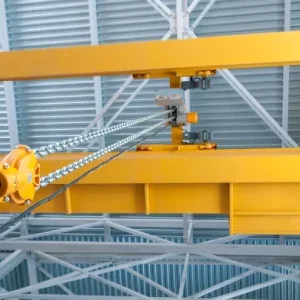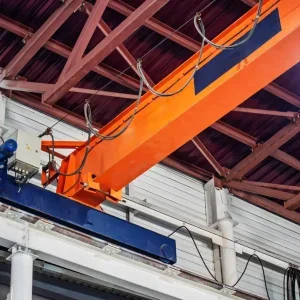In September 2008, NZ Steel approached the company for the commissioning of a 16t crane, intended for the removal and installation of the radiation shaft in its slab-making plant. This was by no means a standard crane design. According to engineer Cobus van der Walt of KraneQuip, a Verlinde reseller in New Zealand, there were a number of constraints and conditions that made this a special design application.
The available space to install the crane was the first problem. “To fit a 16t crane into a four metres of space was a huge challenge, especially when the height of lift was 30 metres,” Van der Walt said. The point load had to move from east to west on the crane girder, however a rope hoist could not do this, due to the size.
“Then we looked at chain hoists. The problem is that the biggest size you can get off the shelf is five tonnes. But this was nowhere close to the 16t we were aiming for.” The team at KraneQuip decided to use two chain hoists that could each lift 10t. But to achieve this, they first had to combine two 5t chain hoists to achieve 10t per assembly, before placing two of these on the crane beam. In the end, they made it by just a few millimetres.
The next challenge was to design a crane beam to accommodate 16t. The maximum standard I-beam was not sufficient and a box girder would have been too expensive. So KraneQuip had to design an I-beam girder with thicker top and bottom flanges to take the load. By not manufacturing a box girder, they shortened the delivery time and spared NZ Steel extra costs.
The sheer size of the chain bags presented another problem: the two hoist assemblies, although well-fitting with the design, could not get close enough to each other to achieve the required east and west approach distances. Due to lack of headroom space, they decided to go wider, rather than lower. This was difficult because the chain had to descend into the full width of the bags. After several modifications, this was achieved by fitting deflector plates in the middle, whilst opening the bags’ throats to allow the chain to fill them properly.
Much fine-tuning was done to ensure that the two hooks ran equally at the same height, and that the limit switches activated at the same time. Further difficulties emerged with the travel speed, since the crane could only move at low speeds in all directions. Despite the use of variable speed controls, the substantial travel time meant a great deal of dust was accumulated on the rails, which resulted in several jams. The solution was to ensure that the rails were blown clean of dust prior to every use. Finally, with the addition of extra-wide wheels to bear the load of the entire crane and the maximum safe working load, the project was complete.
“This project was a unique challenge for the team at KraneQuip and we feel proud that we succeeded with it,” says Van der Walt, “even though sometimes it looked impossible.”






